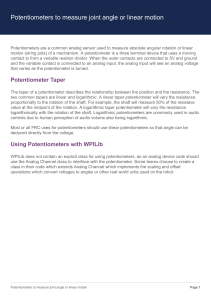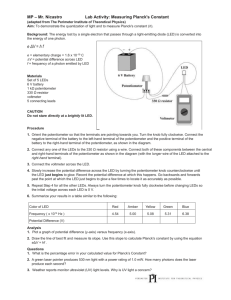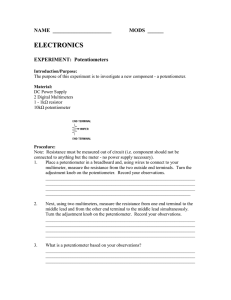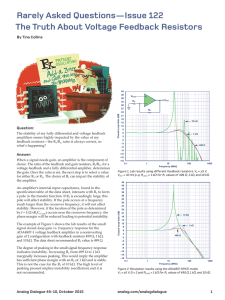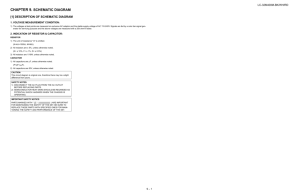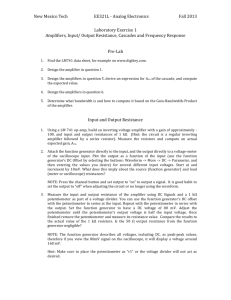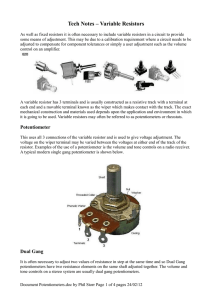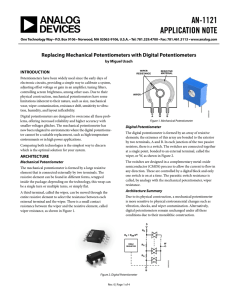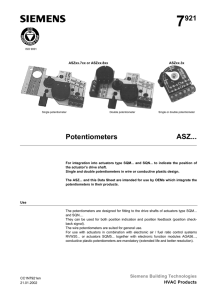a AN-579 APPLICATION NOTE Versatile Programmable Amplifiers Using
advertisement
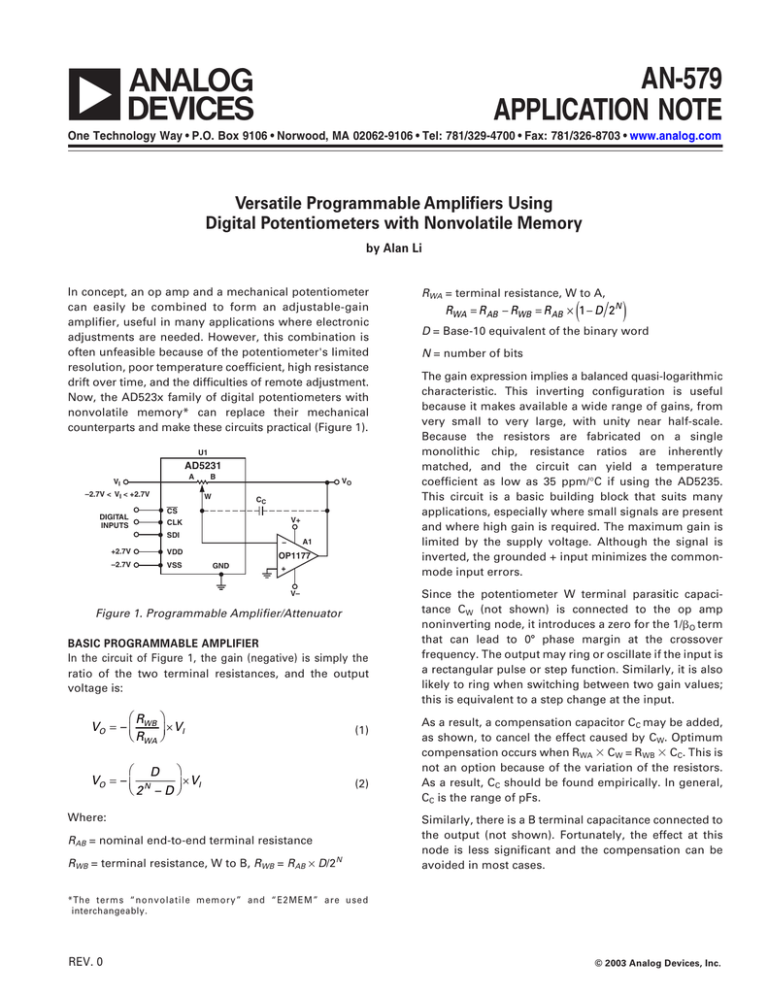
a AN-579 APPLICATION NOTE One Technology Way • P.O. Box 9106 • Norwood, MA 02062-9106 • Tel: 781/329-4700 • Fax: 781/326-8703 • www.analog.com Versatile Programmable Amplifiers Using Digital Potentiometers with Nonvolatile Memory by Alan Li In concept, an op amp and a mechanical potentiometer can easily be combined to form an adjustable-gain amplifier, useful in many applications where electronic adjustments are needed. However, this combination is often unfeasible because of the potentiometer's limited resolution, poor temperature coefficient, high resistance drift over time, and the difficulties of remote adjustment. Now, the AD523x family of digital potentiometers with nonvolatile memory* can replace their mechanical counterparts and make these circuits practical (Figure 1). U1 AD5231 A VI –2.7V < VI < +2.7V DIGITAL INPUTS B W VO CC CS V+ CLK SDI +2.7V VDD –2.7V VSS A1 OP1177 GND V– Figure 1. Programmable Amplifier/Attenuator BASIC PROGRAMMABLE AMPLIFIER In the circuit of Figure 1, the gain (negative) is simply the ratio of the two terminal resistances, and the output voltage is: R VO = – WB ×VI RWA (1) D VO = – N ×VI 2 – D (2) Where: RAB = nominal end-to-end terminal resistance RWB = terminal resistance, W to B, RWB = RAB ¥ D/2N RWA = terminal resistance, W to A, RWA = R AB - RWB = R AB ¥ 1 - D 2N ( ) D = Base-10 equivalent of the binary word N = number of bits The gain expression implies a balanced quasi-logarithmic characteristic. This inverting configuration is useful because it makes available a wide range of gains, from very small to very large, with unity near half-scale. Because the resistors are fabricated on a single monolithic chip, resistance ratios are inherently matched, and the circuit can yield a temperature coefficient as low as 35 ppm/∞C if using the AD5235. This circuit is a basic building block that suits many applications, especially where small signals are present and where high gain is required. The maximum gain is limited by the supply voltage. Although the signal is inverted, the grounded + input minimizes the commonmode input errors. Since the potentiometer W terminal parasitic capacitance CW (not shown) is connected to the op amp noninverting node, it introduces a zero for the 1/O term that can lead to 0ⴗ phase margin at the crossover frequency. The output may ring or oscillate if the input is a rectangular pulse or step function. Similarly, it is also likely to ring when switching between two gain values; this is equivalent to a step change at the input. As a result, a compensation capacitor CC may be added, as shown, to cancel the effect caused by CW. Optimum compensation occurs when RWA ⫻ CW = RWB ⫻ CC. This is not an option because of the variation of the resistors. As a result, CC should be found empirically. In general, CC is the range of pFs. Similarly, there is a B terminal capacitance connected to the output (not shown). Fortunately, the effect at this node is less significant and the compensation can be avoided in most cases. *The terms “nonvolatile memory” and “E2MEM” are used interchangeably. REV. 0 © 2003 Analog Devices, Inc. AN-579 Table I. Circuit Gain vs. D BIPOLAR PROGRAMMABLE-GAIN AMPLIFIER WITH LINEAR STEP ADJUSTMENT In the basic circuit of Figure 1, the output is always inverted with respect to the input, regardless of whether the circuit is providing gain or attenuation. The change in gain as the potentiometer is incremented is nonlinear. While this is useful in some cases, other applications may call for bipolar gain and/or a simple linear relationship. For example, motors need to rotate freely in both forward and reverse directions, thermal electric coolers heat or cool lasers depending upon the direction of current flow, and LCD panels require bipolar voltages for the contrast and brightness controls. In the most general case, to create a bipolar drive with arbitrary end points and linear step adjustment, a dual digital potentiometer, such as the AD5232, can be applied as shown in Figure 2. The output, VO, can now be programmed linearly to amplify voltages between +VI and –K ¥ VI , where K is the ratio of the two terminal resistances of U1 (Equation 1). A2 provides buffered amplification for VW2, minimizing the influence of the wiper resistance. A2 A1 VI U1 1/2 AD5232 VO A2 W2 CC B2 B1 VB –KⴛVi W1 R1 = R2 R2 = 9 ⴛ R1 0 64 128 192 255 –1 –0.5 0 +0.5 +0.992 –2 –1 0 +1 +1.984 –10 –5 0 +5 +9.92 The wiper resistance of the digital potentiometer is the on-resistance of the internal solid-state switches, typically 50 W to 100 W. This is relatively small when compared with the nominal resistance R AB, but the wiper resistance approximately doubles over the operating temperature range and can become the major source of error when the device is programmed to operate at low values. The wiper terminal of the potentiometer should always be connected to a high-impedance node, such as the input terminal of an op amp, as shown in the above circuits. The OP1177 family, the fourth generation of the industry-standard OP07, was chosen for its low offset and low bias-current characteristics. This minimizes the effects of wiper resistance on the voltage divider ratio at the tap point. 1/2 AD5232 R1 = ⴥ, R2 = 0 As implied in Figure 2, R1 and R2 can be replaced by a digital potentiometer—if tight temperature coefficient matching and very high gains are desired. If discrete resistors are used, resistor matching is imperative. OP2177 U2 1/2 D (Step) R2 R1 A1 If the input voltage is high enough such that the voltage across RAB exceeds 5 V at any given setting, discrete resistors should be added in series with the potentiometers to comply with the voltage limitation. See Figure 3. 1/2 OP2177 Figure 2. Bipolar Programmable-Gain Amplifier with Linear Step Adjustment 1/2 The transfer function in Figure 2 is: VO R 2 D2 = 1 + × N1 (1 + K ) – K VI R1 2 AD5232 (3) A2 W2 VI R A2 B2 R3 A1 R B1 U1 1/2 AD5232 R R4 –KⴛVi R W1 VO CC R6 R5 In the simpler (and much more usual) case, where K = 1, a single digital pot, such as the AD5231, is used in location U2, and U1 is replaced by a matched pair of resistors to apply VI and –VI at the end terminals of the digital pot. The relationship will be R 2 2D VO = 1 + – 1 × VI × R1 2N OP2177 U2 1/2 R2 R1 A1 1/2 OP2177 Figure 3. PGA Handles High Input Voltage By configuring the AD523x nonvolatile memory digital potentiometers with the op amps shown in this article, the user can easily design a versatile amplifier with high resolution programmability, bipolar controllability, and linear/log step adjustment capability. (4) Table I shows the result of adjusting D, with A2 configured: as a unity-gain follower (R1 = ⬁, R2 = 0), with a gain of 2 (R1 = R2), and with a gain of 10 (R2 = 9 ¥ R1). The result is a bipolar amplifier with linearly programmable gain and 256-step resolution. –2– REV. 0 AN-579 REFERENCES 1. Sergio Franco, Design with Operational Amplifiers and Analog Integrated Circuits, Second Edition, McGraw-Hill, 1998. 2. The engineering staff of Analog Devices, Inc., Daniel H. Sheingold, editor, Analog-Digital Conversion Handbook, Third Edition. Englewood Cliffs, N.J., Prentice Hall, 1986. 3. Digital Potentiometer Selection Guide (www.analog.com/technology/dataConverters/ designTools). 4. This application note originally appeared as an article in Analog Dialogue, Volume 35, 2001. It can be found on ADI’s website (www.analog.com/library/ analogDialogue/archives/35-03/index.html). REV. 0 –3– E02494–0–1/03(0) PRINTED IN U.S.A. © 2003 Analog Devices, Inc. All rights reserved. Trademarks and registered trademarks are the property of their respective companies. –4–
